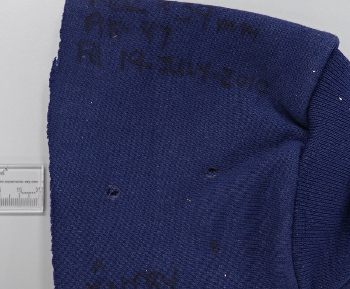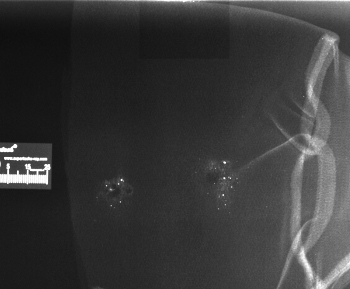Firearm to Target Distance Determination
The presence of a bullet hole is often obvious. More subtle, however, are telltale signs that can indicate the distance from which a firearm was discharged (i.e. muzzle to target distance). In particular, a dark shirt, or a bloodstained shirt may obscure or complicate such determinations. Upon penetration, lead residues from both bullet wipe and gaseous particulate matter are deposited on the shirt. Microtrace has shown that the measured concentrations of these deposits can be useful for determining this muzzle to target distance.
Below, we see two bullet holes through navy sweatshirt. While the holes are visible, we cannot visually observe any obvious residues or unburnt powder, which would indicate a close-range discharge.

Visible image showing the location of two bullet holes in the sleeve of a sweatshirt.
With radiography, we can detect the radiopaque lead particles left in the path of the bullet, as shown below. The relative amount of deposited lead detected around a bullet hole decreases as the muzzle to target distance increases.

X-ray image showing the location of two bullet holes in the sleeve of a sweatshirt.
Our staff at Microtrace have spent an immense amount of time studying bullet holes, bullet-substrate interactions, bullets, and gunshot residues. Our research, teaching, and casework includes:
- The automated analysis of primer gunshot residue by scanning electron microscopy.
- Identification of questioned bullet holes through microscopy and elemental analysis.
- Determining the path of a bullet through the stratigraphy of particles embedded in the leading edge of a bullet.
- The study of 3-D printing materials and related dusts. The dust of 3-D printers may serve as trace evidence used to associate an individual to a 3D printed weapon.
How May We Help You?
Contact usto discuss your project in more detail.







